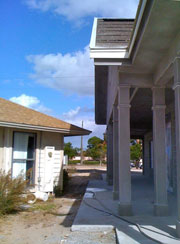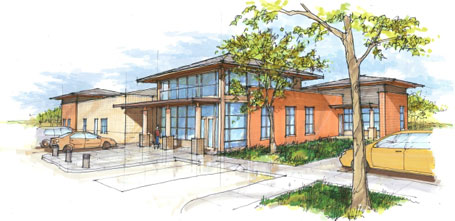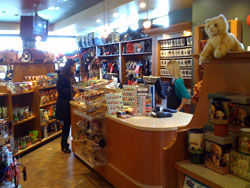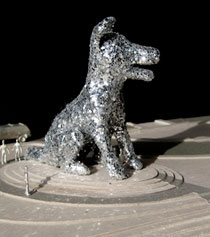|
|
|
|
|
|
|
|
|
|
|
|
|

"I had my own blog for a while, but I decided to go back to just pointless, incessant barking."
|
|
|
|
|
|
|
|
|
Working with What You've Got
|
| |
|
|
With limited affordable land available to build a new facility, the owners of the Morningside Animal Hospital, located in Port St. Lucie, Florida, chose to "work with what they've got" by building on the same site as their existing building. As you can see in the photos, things are really tight, but keeping an eye on the construction couldn't be easier for these doctors. Stay tuned for more on this project in the near future. |
| |
 |
| |
 |
| |
|
|
|
|
|
|
| |
|
|
The first day of spring is also called the vernal equinox. "Vernal" and "equinox" are Latin terms meaning "spring" and "equal night" respectively. |
| |
|
|
| |
Upcoming Events
Meet Tony Cochrane at
The OVMA/AAHA Conference
Toronto, Ontario, Canada
March 24-27, 2011
Meet Larry Gates and
Jeff Keast at
The HSUS Animal Care Expo
Disney Resorts, Florida
May 4-7, 2011
Meet the whole gang at
The ACVIM Forum
Denver, Colorado
June 15-18, 2011
|
|
The Gang
Principals
Lawrence A. Gates
Mark R. Hafen, AIA
Tony L. Cochrane, AIA
Vernita Knapp Cannon
Heather E. Lewis, AIA
Bryan M. King, AIA
Vicki J. Pollard, CVT
Jeffrey A. Keast, AIA, LEED AP
Staff
Amy L. Sanchez
Ashley M. Shoults
Lloyd B. Lewis
Christine J. Fravil
Rachel M. Olson
|
|
|
|

Dancing Dogs Gazette
Animal
Arts Newsletter |
|
| Volume 2, Issue
1 |
March
2010 |
|
|
This is the time of year when we begin to shake ourselves out of those dark days of winter. Spring is just around the corner and hopefully, those monster blizzards, flooding rains and frigid temperatures are just a distant memory. Here in Boulder, the crocuses will soon be poking their heads out of the ground and for those of us fortunate enough to live at the foot of the Rocky Mountains, the skiing will be superb.
While waiting for the weather to improve, I read the New York Times bestseller entitled: "Why We Buy: The Science of Shopping". Written by Paco Underhill, this informative book is based on years of research on how people shop and provides both empirical and scientific reasons for things that we understand intuitively.
Many of the observations and recommendations in Underhill's book can be translated from retail to just about any business including veterinary hospitals, pet resorts and animal shelters. An added benefit is that many changes are simple and can be tried without investing a huge amount of time, effort or money. See the article below for a summary of how the information in this book can help you.
Spring is a time of renewal, rejuvenation and new beginnings. Jump on board, try something new and then let us know how it improves your business.
We'd love to hear about it.
 
Tony Cochrane and the rest of the Gang at Animal Arts |
|
| WhyWe Buy: The Science of Shopping |
|
 How do your clients and customers feel about their experiences in your facility? Have you maximized your potential to provide them with a positive experience or are there challenges that you can improve upon? How do your clients and customers feel about their experiences in your facility? Have you maximized your potential to provide them with a positive experience or are there challenges that you can improve upon?
Underhill recommends observing your clients as they move through your facility to see what works and what doesn't and offers some simple ways to change the negative to a positive. Here are some examples of Underhill's conclusions.
Transition or Decompression Zone
Customers begin their "Transition" into a business by finding the entrance, slowing their pace and gathering an understanding about the layout of the facility. Observations by Underhill have proven time and again that information, signage, displays, and greeters located in this zone do not register in people's minds. The solution: observe how your clients arrive. Give them space to "Transition" and then experiment with the placement of things such as retail displays in a veterinary hospital or a featured pet display in an animal shelter for the best impact.
Read more here
Why We Buy: The Science of Shopping, by Paco Underhill, Simon and Schuster, 2008 |
|
| Let Art Make Your Statement |
|
 This summer, drivers in the bustling urban corridor just south of Denver's downtown will glimpse a large object that sparkles through a break in the trees. Its familiar shape and brilliance amidst the monochromatic industrial landscape will be difficult to miss. That's the idea. This summer, drivers in the bustling urban corridor just south of Denver's downtown will glimpse a large object that sparkles through a break in the trees. Its familiar shape and brilliance amidst the monochromatic industrial landscape will be difficult to miss. That's the idea.
The new Denver Animal Shelter will be fortunate to have the Sun Dog, one of three pieces in a fabulous public art installation designed by artists Laura Haddad and Tom Drugan of Seattle. The 25-foot sculpture is utterly appropriate for the shelter, as its "mutt dog" appearance is easily recognizable. Its bright and faceted surface is made up of hundreds of stainless steel dog tags, a metaphor for pet adoption.
Public art has been showing up in building projects in a big way in recent years. If you are interested in having a unique sculpture or mural in your space, now is a good time to get creative.
Read more here |
|
| Crumbs from the Floor: What's in a Word? |
|
 You may have read about the Border Collie suffering from obsessive compulsive disorder that learned the names of 1,000 toys. While I admire her for humoring her human's mania, I have to wonder if such codependence is healthy. You may have read about the Border Collie suffering from obsessive compulsive disorder that learned the names of 1,000 toys. While I admire her for humoring her human's mania, I have to wonder if such codependence is healthy.
My personal preference is to keep it simple. For example, I've heard that the Eskimos have 100 words for snow. (I assume that comes from being locked up in a doghouse built of ice all winter.) But just the one word will do: snow - something cold, wet, and fun to play in.
Some ideas do deserve more attention. Food for example. Three words are needed; Refrigerator, Boring, and Yuck. Refrigerator food is always good (celery excepted), but humans guard it jealously. Boring covers the filling, but boring, dead, dry sawdust cubes they regularly put in my bowl. And Yuck is what my human calls the delectable delicacies I find in the yard and on adventures through the woods. I must say I am confused by the look on his face when I find these delicacies. Contrary to expectations, he seems anything but pleased by my discoveries.
Patience is necessary when dealing with my humans. They have trouble with consistency. When I was a pup I was labeled Sweetpea, because they said I looked like a butter ball. While I never understood the connection, I was willing to let that go. As I grew up my name somehow morphed into Princess Sweetpea, and while I have to admit that I was a little haughty in my demands of my human wait staff, that moniker seemed a bit unfair.
And now, after years of sacrificing myself to encourage their exercise program, just because my legs are getting a bit stiff, they've started calling me Peg Leg. Personally, I think my name should now be Saint Sweetpea, don't you?
Sweetpea |
|
We hope you enjoyed the latest issue of our newsletter. If you have questions, comments, or news, be sure to jot us a note.
Thanks again,
Tony,
the Staff at Animal Arts and Sweetpea |
|
Animal Arts
4520 Broadway, Suite E
Boulder, CO 80304
If you no longer wish to receive e-mail from Animal Arts, please e-mail us at [email protected] to be removed from our list. |
|